The robot can bust open doors, carry a backpack, and even collect rock samples.
By
Mack DeGeurin
|
Published Feb 23, 2024 3:00 PM EST

Researchers taught this dog-inspired robot to open doors with its leg using a reinforcement learning model. YouTube
Four legged, dog-inspired robots have grown in popularity among scientists and first responders in recent years thanks to their unique ability to quickly and safely maneuver areas hazardous or inaccessible to humans. Some of those robots, like Boston Dynamics’ Spot, can use large claws and other attachments to help them interact with the world around them. But those additional limbs aren’t always ideal since they add weight and take up extra space, both of which could limit the robo-dog’s effectiveness in tight corridors.
Researchers at ETH Zurich’s Robotic Systems Lab in Switzerland tried to solve that dilemma by training their own robot dog to use one of its four limbs to complete tasks like opening a door and moving objects while simultaneously relying on the other three limbs to walk and maintain balance. In a recently released paper documenting their findings, the researchers say they believe this novel use of the robot’s limb could one day aid space exploration and other scenarios where weight and mechanical real-estate are at a premium.
How did the robot dog use its leg?
Researchers used a reinforcement learning model to teach the robot dog, an ANYmal model made by the firm ANYbotic, to complete a series of tasks where it had to manipulate its environment. The model was rewarded with positive reinforcement when the robot placed its front right limb into the desired location. On the flip side, the model revived negative reinforcement when the robot used jerky, potential unsafe movements. From there, the robot learned to use its remaining three legs to balance and move around. Researchers were able to move the robot around using a joystick on a remote controller.
Photos of the experiment show the robot raising its front limb and placing it beside a door handle before shifting its weight to open it. Ironically, the motion isn’t dissimilar to a furry living dog lifting its leg to relieve himself over a fire hydrant. Elsewhere, the robot can be seen wrapping a backpack strap around its limb and then listing the bag up and over into a plastic container. Researchers also experimented with attaching a claw-like gripper to the end of the leg which allowed the robot to successfully grab and collect rock samples. The robot could also use its arm to move small obstacles out of its way and press otherwise difficult to reach buttons.
“Our work shows that numerous manipulation tasks can be solved by only doing pedipulation with quadrupedal robots,” the researchers wrote. “This insight will be relevant for future works on the design and control of legged mobile manipulators.”
Researchers trained the robot on irregular terrain to ensure it could still maintain balance even when faced with less than ideal real-world scenarios it may come across in the real world. To test the robot’s balance, the researchers placed it on top of a slick whiteboard with barely any friction and had it try to complete tasks. It slipped but didn’t fall.
How could this three-legged robo dog be useful
Though the three-legged dog wasn’t necessarily as effective as other models with an attachable claws, the researchers say its real strength is in its simplicity. By forfeiting any additional claws or tools, the researchers their robot avoids adding more unnecessary mechanical complexity. This approach also cuts down on weight and could reduce energy consumption, both of which could prove particularly useful in space exploration or remote search and rescue missions.
At the present, quadruped robots’ general inability to manipulate their environment means they are relegated only to inspection and surveillance tasks. The ETH Zurich researchers findings, however, hint toward a future where these robots can use AI models to learn about the world around them and use their limbs to interact with objects and complete more complicated tasks.
>>> Read full article>>>
Copyright for syndicated content belongs to the linked Source : Popular Science – https://www.popsci.com/technology/robot-dog-opens-door-with-leg/